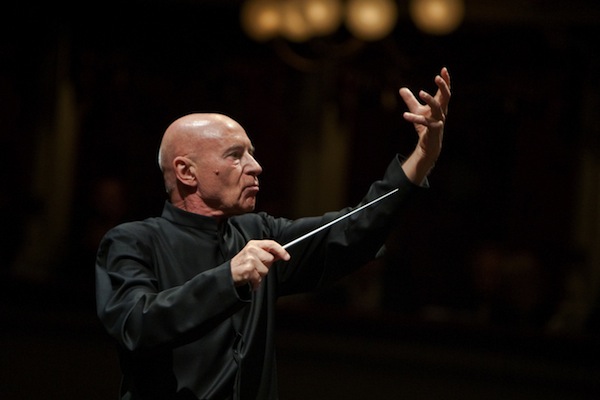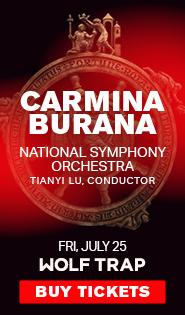Nearing the finish line, Eschenbach leads NSO in a raucous, uneven Mahler Second

Christoph Eschenbach conducted the National Symphony Orchestra in Mahler’s Symphony No. 2 Thursday night.
The Christoph Eschenbach era at the National Symphony Orchestra is drawing to a close.
The ensemble’s current music director ends his tenure with two blockbuster concerts this month, before handing over the reins to his successor, Gianandrea Noseda. The first of these concerts, devoted to Mahler’s Second Symphony, filled the Kennedy Center Concert Hall Thursday night in a way not often seen in recent years.
Eschenbach has only half-completed his cycle of Mahler symphonies during his time in Washington, and previous performances proved a mixed interpretative bag. The stamp he put on the “Resurrection” Symphony was similar, stretching out some of the tempos while rushing through other passages where lingering might have helped. While there was much to admire in the playing, the rashness at the podium rankled as much as it inspired.
The first movement opened with crisply coordinated, violent attacks on the running theme in the cellos and basses. That promising sign belied the less unified parts that followed, including an ensemble issue in the woodwinds in their first entrance. Eschenbach’s unpredictable rubato can produce a pleasing mixture of give and take, but here it led to misalignments across the orchestra.
A section for soft strings, a preview of the transcendent finale, was ethereal, but after the lovely English horn solo, other solo lines were either missed or too covered to hear. Characteristically, Eschenbach focused on odd details, like the chord of piled-up dissonance that leads to the return of the opening material, but ignored others, plowing through delicate solo moments for flute and violin, for example.
An extremely slow tempo for the Andante moderato sapped the lilting Ländler of most of its charm, further making the triplet-laden second theme feel stopped-up rather than flowing. Rather than giving primacy to these themes as the movement progressed, Eschenbach chose to draw out countermelodies in the cello and other sections. The mannered approach, part of a longish interpretation that ran to just over ninety minutes, also undermined the pizzicato section, which plodded.
Eschenbach then took the third movement at an agitated clip, seemingly at odds again with the tempo marking of “In ruhig fliessender Bewegung” (In quietly flowing motion). Most of the gestures Eschenbach applied, including some phrase crescendos that felt almost grotesque, were about exaggeration. This front-loading of neurotic edge meant that the big outbursts later in the movement lost most of their contrasting surprise.
Contralto Nathalie Stutzmann was a small but ardent presence in the “Urlicht” movement, hampered by the placement of the two soloists at the center of the chorus in the seats above the stage. She was not as limited in sound as in last year’s Rückert-Lieder, but Eschenbach was more careful to keep the instrumental sound hushed, making for an affecting moment of stillness before the massive choral finale.
The Washington Chorus nailed the loud conclusion of the last movement, which predictably sparked an enthusiastic ovation from the large audience. More importantly they had a coalesced, warm sound in the ultra-soft first bars of the choral entrance, and their diction was clear without becoming affected.
Soprano Golda Schultz rose out of their massed voices like one of their number before taking flight in an admirable NSO debut, her full-bodied tone distinctive by its thick vibrato. Here the soloist placement paid off, as Schultz was able to project confidently from the chorister seats, her blossoming top notes encouraging the chorus, and all of us, to believe in the possibility of resurrection.
As he had done all evening long, Eschenbach overplayed some of the more effusive gestures. The long percussion roll that leads into a fast section in the finale was dragged out to excruciating length with ear-piercing volume. More effectively, he prolonged the mysterious offstage effects, with brass and timpani placed at various distances in rooms adjacent to the stage. This meant that little room was left for the orchestra to savor other miraculous parts of this most memorable conclusion.
The program will be repeated 8 p.m. Saturday in the Kennedy Center Concert Hall. kennedy-center.org; 202-467-4600.


Posted Jun 04, 2017 at 8:20 am by Andrew K
“Raucus” and “Uneven”? Ridiculous,insulting, and undeserved. It was indelibly and wonderfully performed — sublime — on Saturday night.
Posted Jun 04, 2017 at 9:20 pm by Marcia Diehl
I wonder if this music critic ever took a music lesson or coaching from a true musical master such as the quality of Christoph Eschenbach?
Obviously not.
As for myself, I was extremely blessed in my musical career to be the First-call Substitute in the clarinet section of the Houston Symphony Orchestra when Maestro Eschenbach first became its Music Director back in the mid-1980’s.
I had the honor and privilege to be under the Maestro’s gifted baton 26 times between 1988 and 1990 before I left the Houston area.
I went to hear the National Symphony play the Mahler last Saturday evening. It was good to know that Eschenbach has not only maintained his high standard of excellence on the podium, but that he has actually improved! I thought when I got to perform with him in Houston that he couldn’t get any better….I was wrong.
For musicians who understand the complexity and difficultly to conduct such a magnificent piece, Eschenbach gave an inspiring and magical performance.
Mr. Downey may use musical terms to describe Eschenbach’s liberty with expression, but I doubt very seriously he even has a remote clue what the terms mean and how they are to be used for musical interpretation.
To a trained musician, taking musical liberties is an absolute must to bring a piece of great music alive. If the critic wants to hear Eschenbach give the same musical interpretation of say a Solti or Szell recording, then he should stay home and crank up his CD player.
Musicians on the level of the NSO and other great orchestras crave a great conductor who will make the piece his or her own and use them, the musicians, as the conduit to make his or her “voice” to be heard. In short, Eschenbach “played” the orchestra last night…..and it was breathtaking.
New musical interpretations stimulate orchestra musicians who have played the same piece numerous times over the course of a long career. When a conductor takes many liberties in places not historically done, it wakes up musicians who are used to conductors who take traditional approaches or who literally seem like they have memorized a recording of some other conductor’s work.
When I played under Eschenbach, I knew that I better not have my eyes buried in my music because he became the music so thoroughly and conducted in “the moment” that he could change from performance to performance the slightest phrase ending or tempo change. It was exhilarating!!!
If Mr. Downey noticed any musicians unable to make these sudden interpretive nuances, then it was performer error and only shows that great musicians makes mistakes, too. It makes them more human.
I have lived in the Washington DC area since 1992 and have heard the NSO many times over the last 25 years.
Last Saturday evening’s performance of Mahler’s Second Symphony was the finest performance I have ever heard from the orchestra and a tour de force interpretation by Maestro Eschenbach.
The audience agreed with me…..the Maestro and the orchestra got four bows.
And Mr. Downey needs to go take some music lessons.